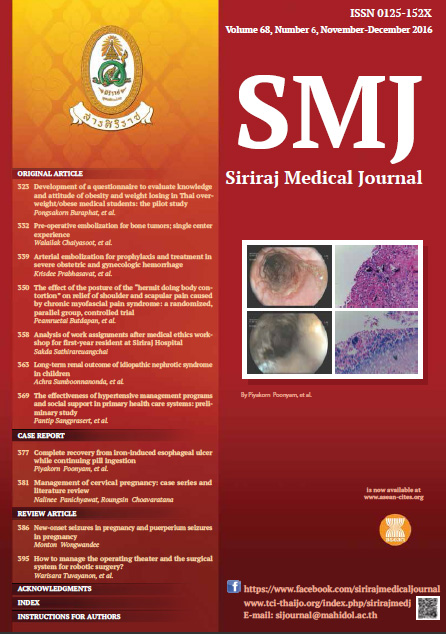Arterial Embolization for Prophylaxis and Treatment in Severe Obstetric and Gynecologic Hemorrhage
Keywords:
Arterial embolization, obstetric hemorrhage, gynecologic hemorrhageAbstract
Objective: To evaluate the efficacy and safety of arterial embolization for prophylaxis and treatment in severe obstetric and gynecologic hemorrhage.
Methods: A retrospective study was conducted among 17 patients who undergone arterial embolization for prophylaxis and treatment in severe obstetric and gynecologic hemorrhage between 2008 and 2013 at Siriraj Hospital. Efficacy of embolization, embolization procedure details, clinical outcomes and complications were collected and analyzed.
Results: The obstetric causes were abnormal placentation (n=6, 35.2%), postpartum hemorrhage (n=5, 29.4%), and intractable bleeding from gynecologic cause (n=6, 35.2%). The median age of the patients in prophylaxis for severe obstetric hemorrhage group, postpartum hemorrhage group and in the gynecologic group were 35 (range, 32-37 years), 31 (range 25-38 years), and 45 (range 28-61 years), respectively. Out of 17 patients, a total of 21 embolization procedures were performed. The technical success rate was 95.6%. Superselection into ovarian artery for embolization of arteriovenous shunting was unsuccessful in one patient. The clinical success rate was 82.6%. Second embolization was done in one patient. Major complication occurred in 3 patients which were microembolism of first dorsal metatarsal artery, pseudoaneurysm at the puncture site and lumbosacral plexopathy.
Conclusion: Arterial embolization has an important role in management of obstetric and gynecologic hemorrhage which is safe, effective and has a low rate of complications.
Downloads
Published
How to Cite
Issue
Section
License
Authors who publish with this journal agree to the following conditions:
Copyright Transfer
In submitting a manuscript, the authors acknowledge that the work will become the copyrighted property of Siriraj Medical Journal upon publication.
License
Articles are licensed under a Creative Commons Attribution-NonCommercial-NoDerivatives 4.0 International License (CC BY-NC-ND 4.0). This license allows for the sharing of the work for non-commercial purposes with proper attribution to the authors and the journal. However, it does not permit modifications or the creation of derivative works.
Sharing and Access
Authors are encouraged to share their article on their personal or institutional websites and through other non-commercial platforms. Doing so can increase readership and citations.











